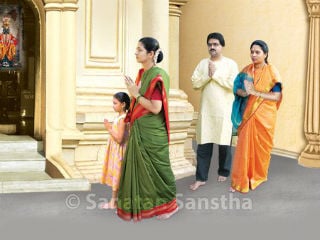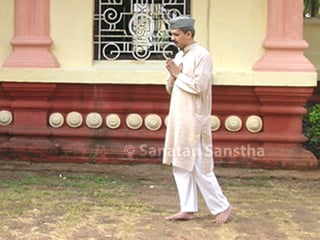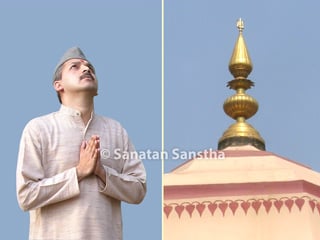A Devalay is divided into seven levels. Each level is connected with a Cosmic Principle and in turn purifies the related chakra (Centre in the body through which the spiritual energy flows) of the person taking darshan (viewing) of a Devalay.
|
Level |
Section of Devalay |
Principle related to Pancha-tattva |
Which deha and kosh of the devotee is purified ? |
|---|---|---|---|
| First | Entrance and Vyaghramukh | Pruthvi | Sthuldeha |
| Second | Compound and Tulsi-vrundavan | Pruthvi and Apa | Prana-deha and pranamay-kosh |
| Third | Water reservoir and array of lamps | Apa and Tej | Manomay-kosh |
| Fourth | The raised square of Kshetrapal Devata and the Mahadwar | Tej | Pranmay-kosh and manomay-kosh |
| Fifth | The pathway for pradakshina, steps and sabhamandap (mirror, bell and the terrace) | Vayu | Sukshmadeha |
| Sixth | Garbhagar, Yadnyakund, the Idol of Suryanarayan | Vayu and Akash | Sukshmadeha and Prandeha |
| Seventh | Garbha-gruh, Nandadeep, the small Devalay, Go-mukh, kalash and the flag on it | Akash | Sthuldeha and Sukshmadeha |
The components of all the seven levels in the structure of a Devalay have the capacity to attract the corresponding Principle amongst the five Cosmic Principles in the universe and also of purifying the corresponding energy chakra of the individual. These seven levels of the structure of a Devalay denote the journey of purification of the darshanarthi (One having darshan) from the Muladhar-chakra (First centre in the spiritual energy system located in the region between the anus and the base of the genitals in the subtle body) to the Sahasrar-chakra (Last centre in the spiritual energy system located at the top of the head in the subtle body). Due to this unique arrangement of the Devalay structure, from the seventh level (Akash-tattva [Absolute Ether Principle] associated with nirgun [Non-materialised]) to the first level (Pruthvi-tattva [Absolute Earth Principle] associated with sagun [Materialised]), meaning, from the kalash (Dome of a temple) to the main door of the Devalay, nirgun waves of the Deity Principle get transformed into sagun waves. This helps the individual entering the Devalay to get maximum benefit of the sagun Principle of the Deity. This shows the deep and subtle thought for the darshanarthi from the perspective of God-realisation. Such a deep and subtle thought is not evident in the architecture of prayer places of other sects. It will be clear from these facts, how, when compared with other sects, Hindu Dharma is superior and perfect. – A Scholar (Through the medium of Mrs. Anjali Gadgil, 16th January 2005, 10.19 p.m.).
Reference : Sanatan’s Holy text : ‘How Should One Have Darshan in a Temple’

 Importance of donating after having darshan (viewing) in a Devalay (Temple)
Importance of donating after having darshan (viewing) in a Devalay (Temple) Actions to be performed while leaving the Devalay (Temple) and their underlying science
Actions to be performed while leaving the Devalay (Temple) and their underlying science How many pradakshinas (circumambulations) should be performed around a Deity ?
How many pradakshinas (circumambulations) should be performed around a Deity ? Actions to be performed before entering a Devalay (Temple) and the underlying science
Actions to be performed before entering a Devalay (Temple) and the underlying science Method of going from the premises towards the sabhamandap of the Devalay (Temple)
Method of going from the premises towards the sabhamandap of the Devalay (Temple) Why should we have darshan (viewing) of the kalash (Dome) as soon as we enter...
Why should we have darshan (viewing) of the kalash (Dome) as soon as we enter...